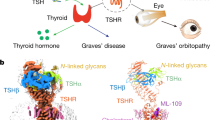Abstract
Anti-TSH receptor antibodies (TRAbs) have been known to be involved in Graves’ disease and primary hypothyroidism. We previously isolated and reconstituted immunoglobulin (Ig) genes of Epstein-Barr virus-transformed B cell clones producing monoclonal TRAbs obtained from Graves’ patients. In the present study, we performed a similar experiment using a B cell clone, 32A-5, derived from a patient with primary hypothyroidism. The variable region genes of Ig heavy (H) and light (L) chains were isolated and sequenced from the 32A-5 clone. A significant number of somatic mutations were found in variable regions of H and L chain gene segments. Each pair of H and L chain cDNAs was ligated into an expression vector for IgG1 production and stably introduced into myeloma cells. The transfectants were injected ip into BALB/c mice to yield ample volume of the antibody for following applications. Interactions of recombinant 32A-5 with Graves’ sera with varying thyroid-stimulating antibody (TSAb) activities were studied. The recombinant antibody tended to suppress TSAb activities in 10 of 15 Graves’ sera, in which four were significantly inhibited. In summary, this is the first study to analyze human monoclonal TSH-stimulation blocking antibodies (TSBAb) at the molecular level. Use of human recombinant monoclonal TSBAb may be an analytical tool for molecular-basis etiology and an alternative therapeutic path for Graves’ disease.
Similar content being viewed by others
References
Smith BR, McLachlan SM, Furmaniak J. Autoantibodies to the thyrotropin receptor. Endocr Rev 1988, 9: 106–21.
Rapoport B, Chazenbalk GD, Jaume JC, McLachlan SM. The thyrotropin (TSH) receptor: interaction with TSH and autoantibodies. Endocr Rev 1998, 19: 673–716.
Akamizu T, Kohn LD, Mori T. Molecular studies on thyrotropin (TSH) receptor and anti-TSH receptor antibodies. Endocr J 1995, 42: 617–27.
Akamizu T, Matsuda F, Okuda J, et al. Molecular analysis of stimulatory anti-thyrotropin receptor antibodies (TSAbs) involve in Graves’ disease. J Immunol 1996, 157: 3148–52.
Li H, Akamizu T, Okuda J, et al. Isolation of Epstein-Barr virus-transformed lymphocytes producing IgG class monoclonal antibodies using a magnetic cell separator (MACS): preparation of thyroid-stimulating IgG antibodies form patients with Graves’ disease. Biochem Biophys Res Commun. 1995, 207: 985–93.
Shin EK, Akamizu T, Matsuda F, et al. Variable-regions of immunoglobulin heavy-chain genes encoding anti-thyrotropin (TSH) receptor antibodies of patients with Graves’ disease. J Immunol 1994, 152: 1485–1492.
Okuda J, Akamizu T, Sugawa H, Matsuda F, Li H, Mori T. Preparation and characterization of monoclonal antithyrotropin receptor antibodies obtained from primary myxedema. J Clin Endocrinol Metab 1994, 79: 1600–4.
Shlomchik MJ, Rothstein AM, Wolfowiz CB, Rothstein TL, Weigert MG. The role of clonal selection and somatic mutation in autoimmunity. Nature 1987, 328: 805–11.
Akamizu T, Moriyama K, Miura M, Saijo M, Matusda F, Nakao K. Characterization of recombinant monoclonal anti- thyrotropin receptor antibodies (TSHRAbs) derived from lymphocytes of patients with Graves’ disease: Epitope and binding study of two stimulatory TSHRAbs. Endocrinology 1999, 140: 1594–1601.
Neoh SH, Gordon C, Potter A, Zola H. The purification of mouse monoclonal antibodies. J Immunol Methods 1986, 91: 231–5.
Skarlatos S, Pardridge WM. Targeting of an anti-CR3 (CD11b/CD18) monoclonal antibody to spleen but not brain, in vivo in mice. J Drug Target 1995, 3: 9–14.
Suzuki I, Pfister L, Glas A, Nottenburg C, Milner EC. Representatoin of rearranged VH gene segments in the human adult antibody repertoire. J. Immunol 1995, 154: 3902–11.
Brezinschek HP, Brezinschek RI, Lipsky PE. Analysis of the heavy chain repertoire of human peripheral B cells using single-cell polymerase chain reaction. J Immunol 1995, 155: 190–202.
Ichihara Y, Matsuoka H, Kurosawa. Y. Organization of human immunoglobulin heavy chain diversity gene loci. EMBO J 1988, 13: 4141–50.
Buluwela L, Alberson DG, Sherrington P, Rabbitts PH, Spurr N, Rabbitts TH. The use of chromosomal translocations to study human immunoglobulin gene organization: mapping DH segments within 35 kb of the Cm gene and identification of new DH locus. EMBO J 1988, 7: 2003–10.
Honjo T, Alt FW. Immunoglobulin genes. 3rd ed. London: Academic Press 1995.
Radoux, V, Chen PP, Sorge JA, Carson DA. A conserved human germline Vk gene directly encodes rheumatoid factor light chains. J Exp Med 1986, 164: 2119–24.
Straubinger B, Huber E, Lorenz W, et al. The human VK locus. Characterization of a duplicated region encoding 28 different immunoglobulin genes. J Mol Biol 1998, 199: 23–34.
Ikematsu W, Kobarg J, Ikematsu H, Ichiyoshi Y, Casali P. Clonal analysis of a human antibody response. III. Nucleotide sequences of monoclonal IgM, IgG, and IgA to rabies virus reveal restricted V kappa gene utilization, junctional V kappa J kappa and V lambda J lambda diversity, and somatic hypermutation. J Immunol 1998, 161: 2895–905.
Hutchins JT, Kull FC Jr, Bynum J, Knick VC, Thurmond LM, Ray P. Improved biodistribution, tumor targeting, and reduced immunogenicity in mice with a gamma 4 variant of Campath-1H. Proc Natl Acad Sci USA 1995, 2: 11980–4.
Author information
Authors and Affiliations
Corresponding author
Rights and permissions
About this article
Cite this article
Moriyama, K., Okuda, J., Saijo, M. et al. Recombinant monoclonal thyrotropin-stimulation blocking antibody (TSBAb) established from peripheral lymphocytes of a hypothyroid patient with primary myxedema. J Endocrinol Invest 26, 1076–1080 (2003). https://doi.org/10.1007/BF03345253
Accepted:
Published:
Issue Date:
DOI: https://doi.org/10.1007/BF03345253




